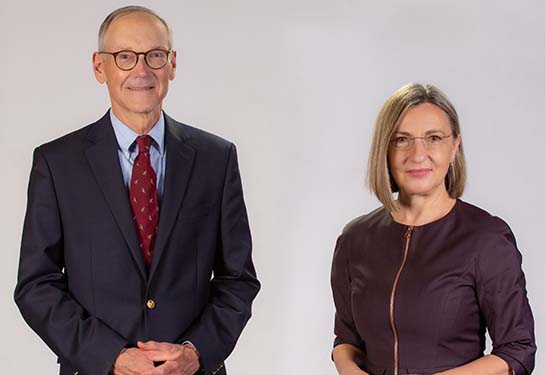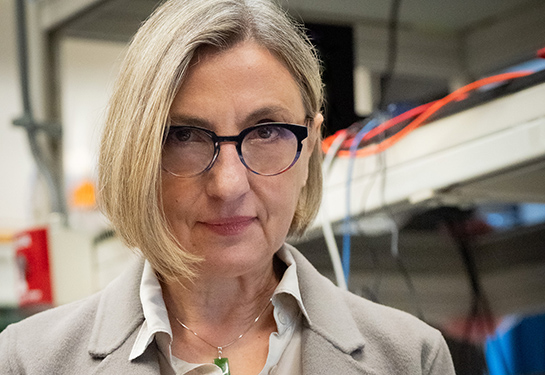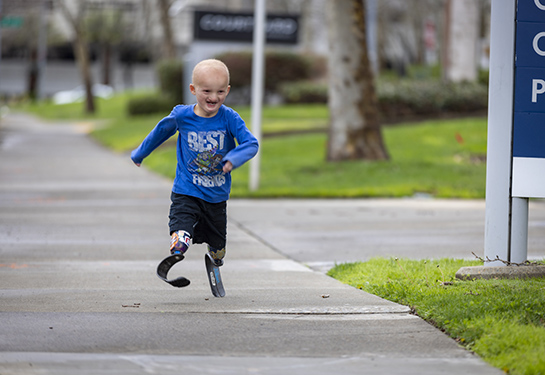NIH Grant Creates National Center at UC Davis
Light-Based, AI Technologies Could Transform Interventional Health Care
A new center that stands to transform surgical procedures and brain monitoring on a national scale using light-based, artificial intelligence-informed technologies will soon be part of Aggie Square at the University of California, Davis, thanks to a recent $6.3 million P41 grant from NIH’s National Institute of Biomedical Imaging and Bioengineering.
The National Center for Interventional Biophotonic Technologies, or NCIBT, will advance two optical imaging technologies developed at UC Davis — interventional fluorescence lifetime imaging, or iFLIM, and interferometric diffuse optical spectroscopy, or iDOS — and combine them with an AI-deep learning platform to provide real-time guidance of decision-making during medical and surgical procedures. The center will support research and development, clinical application, and training and education of the new technologies and promote their adoption to improve the quality of interventional health care.
“We are developing a new technological paradigm for surgical and interventional medical decision-making,” said Laura Marcu, founding director of NCIBT and professor in the UC Davis College of Engineering’s Department of Biomedical Engineering. “This technology will help surgeons and other physicians make decisions in real time by assessing the local tissue’s constituents, physiology and pathology, and integrating this imaging data with preoperative and other intraoperative imaging data and information from a patient’s history, to optimize the procedure.”
The grant will also support the establishment of a physical center at UC Davis’ Aggie Square. This will include state-of-the-art laboratories, teaching space, learning centers and the organizational headquarters of the center’s training and education programs.
“Aggie Square supports advancements of biomedical technologies and close collaborations among engineers, clinician-scientists and industry. These promote development of clinically useful tools and dissemination of these discoveries and tools through teaching, training and commercialization,” said Griff Harsh, professor and chair of neurological surgery at UC Davis Health, and deputy director and training leader of NCIBT. “We believe that the NCIBT embodies the mission and vision of Aggie Square.”
NCIBT adds to the growing number of AI-based centers at UC Davis, including the AI Institute for Next Generation Food Systems, or AIFS, and Center for Data Science and Artificial Intelligence Research, or CeDAR.
Recognizes engineer leaders, clinical collaborators
The highly competitive P41 grant is one of the NIH-NIBIB’s primary means for supporting the development and clinical application of very promising technologies in optical imaging and engineering. It recognizes the efforts and potential of highly productive teams of scientists who are leaders in their fields, and promotes clinical collaborations for developing, testing and disseminating imaging technologies that will positively impact human health.
“Decision-making about how extensive surgery must be to completely remove tumors relies heavily on the surgeon’s experience, and sometimes requires repetitive and time-consuming lab analysis of tissue around the cancer to make sure all the tumor is gone,” said David Lubarsky, CEO of UC Davis Health and a fellow of the American Society of Anesthesiologists. “This new national center will build on strengths unique to UC Davis’ School of Medicine and College of Engineering, developing new optical tools to help surgeons everywhere more often provide complete cures for their patients.”
The scale and collaborative nature of the proposal led the team to enlist help from the Interdisciplinary Research and Strategic Initiatives division in the UC Davis Office of Research in organizing the team and preparing a successful proposal. That support included hosting multiple workshops, coordinating collaborations with partner institutions, developing the proposal and preparing for the sponsor’s site visit.
In being selected, UC Davis joins an elite cohort of two dozen institutions in the country with a P41 center, which are supported by the National Institute of Biomedical Imaging and Bioengineering, or NIBIB. Other universities include Stanford University, Johns Hopkins University, Massachusetts Institute of Technology and New York University School of Medicine. The P41 grant has an initial five-year term and is potentially renewable for a total of 15 years. These P41 grants historically have engendered numerous other NIH grants for further development and applications of a center’s technologies.
According to NIBIB Director Bruce J. Tromberg, the UC Davis P41 center has the potential to rapidly advance optical imaging technologies that use AI-informed instruments. Such technologies could have a significant impact on the management of common afflictions, including cancer, stroke, heart disease, trauma, infection and degenerative diseases. Tromberg also noted the center’s opportunity to both collaborate on a wide range of research projects and eventually translate its discoveries into clinical applications.
“The NCIBT provides a unique opportunity, with its outstanding team of lead investigators at UC Davis and national network of engineers and clinician-scientists, to develop and validate a series of game-changing technologies, while expanding their use and impact through collaborative research, training and commercialization,” Tromberg said. “This effort could bring about significant improvements in patient outcomes, as well as improved access to life-saving surgical procedures.”
How it works
The center’s scientific focus is to integrate UC Davis’ expertise in iFLIM, iDOS and AI to create state-of-the-art optical imaging instruments for tissue characterization during surgical procedures and monitoring of blood flow in a variety of medical conditions.
“We are bringing these three technologies together to develop a new generation of fiber-based, scalable and easily deployable optical devices. They will interface with an analytical platform that will provide a surgeon or physician with instant information and analysis to guide clinical decision-making during the actual process,” Marcu said.
Both imaging technologies are noninvasive and measure fluctuations in light emanating from tissues — meaning how light is diffused or absorbed or emitted by the tissue or cells. IFLIM, developed by Marcu’s lab, uses light measurements through a hand-held, penlike diagnostic probe in an open or endoscopic procedure to determine the tissues’ molecular constituents. This information helps determine the prevalence of healthy versus altered tissue. IDOS, developed by Adjunct Professor of Biomedical Engineering at UC Davis Vivek Srinivasan, uses similar, light-based optical imaging that is able to penetrate the scalp and skull to determine brain blood flow.
This raw imaging data is then analyzed by deep learning algorithms, developed in Professor Jinyi Qi’s lab in biomedical engineering in collaboration with other experts in AI from CeDAR, to instantaneously provide information regarding tissue constituents, blood flow and metabolism.
The goal is to provide clinicians with imaging information, data analysis, easily interpretable image presentations and decision-making support in real time during an operation or patient monitoring. This information will then help guide the clinician toward choices that will improve patient outcomes. Clinical applications of this technology include identification of tissue types during open or intravascular surgery and the measurement of brain blood flow in the intensive care unit or clinic.
“It is rewarding to see technologies developed in engineering labs go from bench to patient and, eventually through this center, from patient to population,” Marcu said, “and how engineering principles can provide pathways to create technologies and tools that can impact public health by improving patient outcomes.”
In addition to using machine-learning analysis to promote real-time decision-making, Marcu and the team are partnering with Professor Adyogan Ozcan of UCLA’s Department of Electrical and Computer Engineering to use AI to inform the holistic design of the optical instruments. AI will inform choices regarding the size, fidelity and sensitivity of the instrument to a tissue’s molecular features to optimize data collection and analysis.
Network of innovative, collaborative projects
Support of collaborative clinical projects that could benefit from NCIBT’s technology and expertise is an important aspect of NCIBT’s mission. To implement these projects, NCIBT’s leaders, with support from the UC Davis Office of Research, assembled a consortium of more than 60 research teams from throughout the country.
Initially, 12 clinical projects, led by principal investigators from 10 academic research institutions and two companies, will be conducted under the auspices of the center. Research projects include: definition of surgical margins of brain, breast, head and neck tumors; identification of tissue types during fetal repair of spina bifida or breast reconstruction after mastectomy; classification of types of retinal disease; guidance of intravascular procedures for coronary artery atherosclerosis; and measurement of brain blood flow during learning of new tasks, in Alzheimer’s disease, or after trauma or stroke. NCIBT will also disseminate technologies throughout the University of California’s network of medical schools.
Training and dissemination of education
Educating others in these technologies and providing training in the use of the tools that incorporate the center’s technological advancements are important components of the NCIBT’s mission, according to Harsh, who will lead the NCIBT’s training and dissemination efforts with Randy Carney, an assistant professor in biomedical engineering. The center will host education and training programs, a biophotonic-focused weeklong workshop at UC Davis, and lectures and demonstrations at national scientific and medical meetings for engineers and clinicians who want to learn to use this new technology.
“Operating at the interface of engineering and medicine, we will train engineers — whether graduate students, postdoctoral fellows, or faculty investigators — to use these technologies in their own tool development, and we will train physicians — whether medical residents, clinician-scientists, or physicians in practice — in the clinical use of the tools developed,” Harsh said. “We are optimistic that, ultimately, patients will benefit.”




